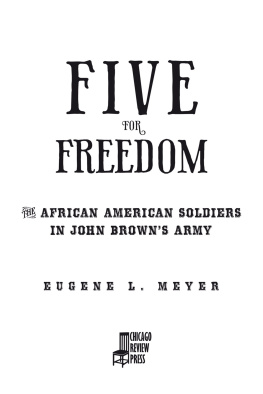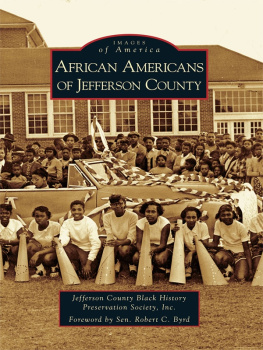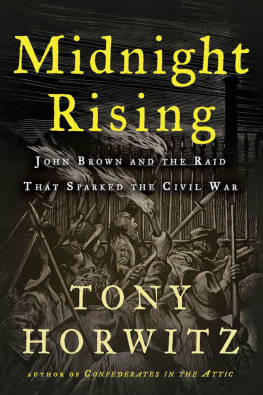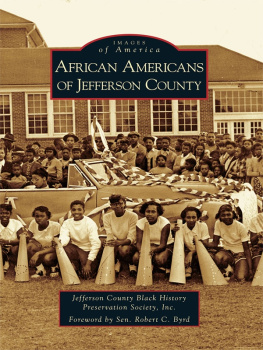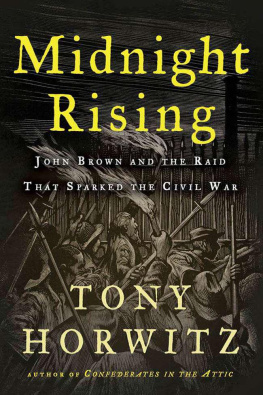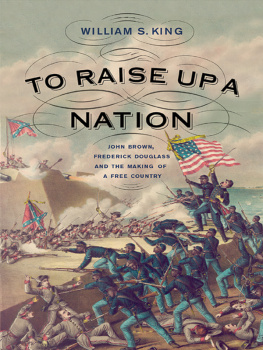Copyright 2018 by Eugene L. Meyer
For James P. Shenton
Cast of Characters
Osborne Perry Anderson (18301872) was the sole survivor of the raid and in 1861 published the only insider account, A Voice from Harpers Ferry. Born in West Fallowfield, Chester County, Pennsylvania, he immigrated in 1851 to Chatham, Canada West, after passage of the 1850 Fugitive Slave Act. There he worked for Mary Ann Shadd Carys Provincial Freeman newspaper and participated in John Browns conference to adopt a provisional constitution for the future free state to be created in the Appalachian Mountains.
Fontaine Beckham (17961859) was a native of Culpeper County, Virginia, and serving his first term as mayor of Harpers Ferry when the raid occurred. He was also the stationmaster for the Baltimore and Ohio Railroad there. He was closely associated with Haywood Shepherd, a free man of color who also worked for the railroad and was the first fatality of the raid. The following day, Browns men fatally shot Beckham on the streets of the town.
John Brown (18001859) was born in Torrington, Connecticut, and moved to Hudson, in northeastern Ohio, at the age of five. His father, Owen, a deeply religious man, instilled in him a strong sense of morality that included opposition to slavery. Brown lived in several states and had twenty children with two wives. Nine of his children did not survive to adulthood; three sons died in antislavery campaigns, one in Kansas and two at Harpers Ferry. Brown was captured at Harpers Ferry, then convicted and hanged in Charlestown, Virginia (now Charles Town, West Virginia) on December 2, 1859. He is buried in North Elba, North York.
Mary Ann Shadd Cary (18231893), born in Wilmington, Delaware, and raised in West Chester, Pennsylvania, was the mixed-race daughter of a prominent abolitionist. An educated woman of strong feelings and fiery temperament, she taught school in Pennsylvania, New Jersey, and New York before immigrating in 1851 to Canada, where she became the first black female newspaper editor in North America, employing Osborne Anderson as a printer. After recruiting black men to join the Union Army, she moved to Washington, DC, where she was a schoolteacher and principal, obtained a law degree from Howard University, and was active in the suffragist movement.
John Anthony Copeland (18341859) attended Oberlin College in 1854 and participated in the Oberlin-Wellington rescue of escaped slave John Price. From his jail cell in Charlestown, Virginia, he wrote several poignant letters to friends and family prior to his execution on December 16, 1859.
Shields Green (18361859) was a fugitive slave from Charleston, South Carolina, who escaped on a ship after his wife died, leaving a young son. He eventually reached Rochester, New York, where he stayed for a time with Frederick Douglass, met John Brown, and advertised his services as a clothes cleaner. He was also known as the Emperor, for his alleged descent from an African king, and as Esau Brown. Accompanying Douglass to a meeting with Brown at a quarry in Chambersburg, Pennsylvania, in August 1859, Green chose to go with the old man.
Andrew H. Hunter (18041888), the prosecutor in the Harpers Ferry cases, later had high praise for John Anthony Copeland, saying he was the defendant who most impressed him with his demeanor and dignity. Hunter served two years in the Confederate Virginia House of Delegates and was an advisor to Gen. Robert E. Lee on civil and military matters.
Lewis Sheridan Leary (18351859) was a saddle and harness maker from Oberlin and related by marriage to Copeland. Leary left his wife and child to join John Browns raid on Harpers Ferry and was fatally wounded while trying to escape across the Shenandoah River.
Dangerfield Newby (c.18201859) was the son of a white father and an enslaved mother (with a different owner). He was an enslaved skilled blacksmith who met and wed Harriet, a slave. Together, they had as many as seven children. Newby, freed when his father moved his family to Ohio in 1858, attempted to purchase the freedom of his wife and children. After that failed, he joined Brown in hopes of liberating his family.
Richard Parker (18101893) was the judge who presided over the trials of John Brown and associates John Copeland, Shields Green, John Cook, and Edwin Coppoc. He imposed the death sentence on all. Years later, he praised Copeland. Parker represented his district in the US House of Representatives from 1849 to 1851.
Haywood Shepherd (18151859), a free man of color from Winchester, Virginia, owned property and had a wife and children. He worked for the Winchester and Potomac Railroad, which ran daily trains to Harpers Ferry, where he assisted with luggage. The night of the raid, John Browns men ordered Shepherd to halt and fatally shot him when he ignored them. He died the next day and was buried in Winchester. After his death, his wife and children moved to Washington, DC.
Henry A. Wise (18061876), a former diplomat and congressman, served as governor of Virginia from 1857 to 1861 and asserted state sovereignty in the prosecutions arising from John Browns raid. He signed the death warrants for the convicted conspirators. A slaveholder in Accomack County on Virginias Eastern Shore, Wise initially opposed the doctrine of secession but changed his position and served as a high-ranking officer in the Confederate Army.

